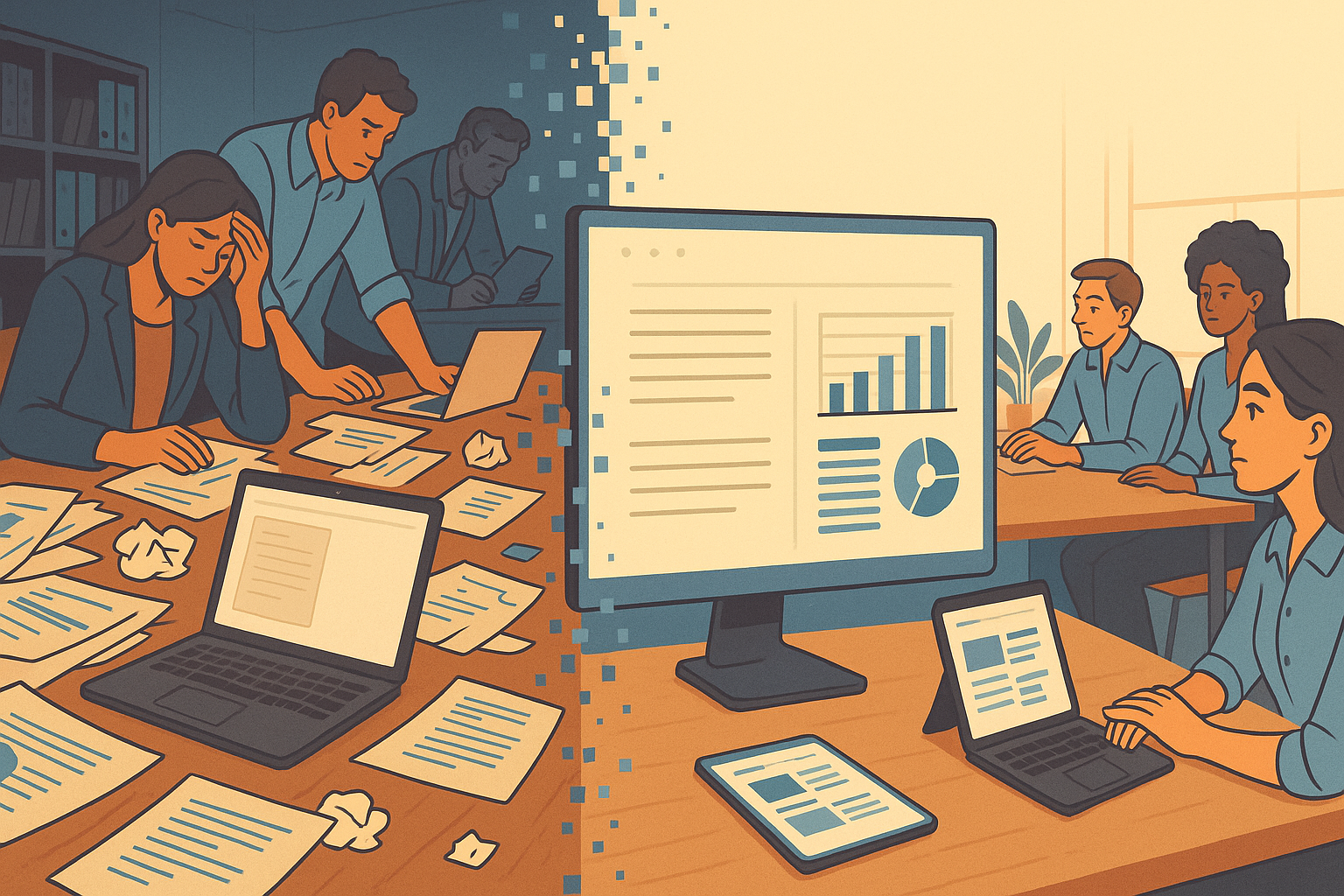Why Smart Companies Are Abandoning Ad-Hoc Documents for Strategic Template Systems (And You Should Too)

The workplace revolution isn't happening in flashy AI tools or expensive collaboration platforms - it's happening in the mundane, everyday documents that keep businesses running. Whilst everyone's talking about hybrid work trends and office design, the smartest organisations are quietly transforming their productivity through something far more fundamental: how they create, manage, and standardise their business documents.
We're witnessing a dramatic shift away from the "start from scratch" mentality that has dominated business document creation for decades. Forward-thinking companies are discovering that the secret to scaling efficiently isn't hiring more people or buying more software - it's building intelligent document systems that eliminate the friction, inconsistency, and time-wasting that plague traditional workflows.
If your organisation is still relying on employees to reinvent the wheel every time they create a presentation, proposal, or report, you're not just losing productivity - you're actively handicapping your team's ability to focus on what actually matters: strategic thinking, creative problem-solving, and delivering value to clients.
Let's explore why the most successful organisations are making this shift, and what it means for businesses that want to stay competitive in 2025 and beyond.
The Hidden Productivity Crisis
Before we dive into solutions, we need to acknowledge a problem that's hiding in plain sight across Australian businesses: the staggering amount of time teams spend on document formatting, searching for the right templates, and recreating structures that should already exist.
Recent research into workplace productivity reveals a troubling pattern. Teams are spending an average of 2.5 hours per week just on document formatting tasks - that's over 10% of the working week dedicated not to thinking, strategising, or creating value, but to adjusting margins, choosing fonts, and figuring out how to make a presentation look professional.
The Blank Page Paralysis
There's a cognitive phenomenon that productivity researchers call "blank page syndrome" - the mental friction that occurs when teams face unstructured document creation tasks. Instead of diving into substantive work, they get bogged down in structural decisions that shouldn't require any mental energy at all.
We've seen this countless times in our work with Australian organisations. Marketing teams spending forty minutes debating slide layouts before they've even considered the message. Finance departments recreating the same budget format every quarter because no one can find last year's version. HR teams rebuilding policy documents from scratch because the previous template wasn't saved properly.
This isn't just inefficient - it's cognitively exhausting. Every formatting decision, every structural choice, every "should this be a bullet point or a numbered list?" moment represents decision fatigue that robs teams of mental energy they could be using for strategic thinking.
The Consistency Challenge
Beyond individual productivity losses, ad-hoc document creation creates massive consistency problems that compound over time. When different team members create documents independently, you end up with:
- Brand presentations that look like they came from different companies
- Proposals with varying quality levels and professional standards
- Reports that follow different structures, making them harder to review and compare
- Training materials that confuse rather than clarify because of inconsistent formatting
Professional presentation design services understand this challenge intimately. It's not enough to create beautiful templates - you need systems that ensure those templates actually get used consistently across the organisation.
The Strategic Template Revolution
Smart organisations are moving beyond thinking of templates as simple time-savers to recognising them as strategic business infrastructure. This shift represents a fundamental change in how companies approach document workflows, knowledge management, and operational efficiency.
Templates as Strategic Assets
The most sophisticated Microsoft Office template customisation we've implemented goes far beyond aesthetic improvements. These systems embed business logic, ensure compliance requirements, automate routine processes, and create frameworks that guide strategic thinking.
Consider how a well-designed proposal template can do more than save formatting time. It can prompt teams to consider key strategic questions, ensure that all necessary legal disclaimers are included, automatically calculate pricing based on predefined parameters, and generate follow-up task lists once the proposal is sent.
Similarly, professional PowerPoint templates can include built-in storytelling frameworks that guide presenters through logical argument structures, ensure brand compliance across global teams, and even integrate with data sources to automatically update key metrics.
The Workflow Integration Advantage
Modern Microsoft 365 template solutions don't exist in isolation - they integrate with broader business workflows to create seamless productivity systems. When templates are properly integrated with collaboration tools, project management systems, and data sources, they become powerful automation engines.
We've helped organisations create template systems where:
- Project kick-off documents automatically generate corresponding tracking spreadsheets and presentation frameworks
- Client proposal templates pull in relevant case studies and pricing information based on industry and project type
- Monthly report templates connect to data sources to automatically populate key metrics and generate visual dashboards
This level of integration transforms templates from static documents into dynamic business tools that enhance rather than constrain creative thinking.
The Competitive Advantage of Systematic Thinking
Organisations that invest in strategic template systems often discover benefits that extend far beyond time savings. These systems create competitive advantages that compound over time and become increasingly difficult for competitors to replicate.
Knowledge Capture and Scaling
Professional Microsoft Office templates can capture and systematise the knowledge of your best performers, making that expertise available across the organisation. When your top salesperson's proposal structure is embedded in a template system, every member of the sales team can benefit from those insights.
This knowledge capture becomes particularly valuable as teams grow and new employees join the organisation. Instead of hoping that tribal knowledge gets passed down through informal mentoring, template systems ensure that best practices are automatically embedded in day-to-day workflows.
Quality Standardisation
One of the most significant advantages of strategic template systems is their ability to establish minimum quality standards across all document outputs. When templates include proven structures, professional design elements, and built-in compliance checks, even junior team members can produce work that meets senior-level standards.
This quality standardisation has profound implications for client relationships, brand perception, and operational efficiency. Clients receive consistently professional communications regardless of which team member they're working with, and internal stakeholders can rely on predictable document quality for decision-making processes.
Rapid Scaling Capability
As organisations grow, template systems become force multipliers that enable rapid scaling without proportional increases in oversight or quality control. New team members can immediately produce professional-quality work using established frameworks, and geographic expansion doesn't require extensive training on local document standards.
The Technology Integration Factor
The workplace trends shaping 2025 are creating new opportunities for template systems to deliver even greater value through integration with emerging technologies and evolving work patterns.
Hybrid Work Enhancement
With teams increasingly distributed across different locations and time zones, template systems provide the shared frameworks that maintain consistency and quality regardless of where work gets done. Digital templates serve as virtual collaboration spaces where ideas, feedback, and decisions are documented systematically.
Professional presentation design services are adapting to support hybrid work patterns by creating templates that work equally well for in-person presentations and virtual meetings, with built-in features that enhance remote viewing experiences.
AI-Enhanced Productivity
Whilst everyone's talking about AI disrupting work, the most practical applications often involve enhancing existing template systems rather than replacing them. AI can power template features like:
- Intelligent content suggestions based on document context and historical data
- Automated formatting optimisation that adapts to different output requirements
- Dynamic content generation that pulls relevant information from various sources
- Quality checking that identifies potential compliance or brand consistency issues
The key is that these AI enhancements work within established template frameworks rather than creating additional complexity or uncertainty.
The Implementation Reality
Transforming document workflows through strategic template systems isn't just about creating better-looking documents - it requires thoughtful change management and systematic implementation that considers how people actually work.
User Adoption Strategies
The most beautifully designed templates are worthless if teams don't actually use them. Successful implementation requires understanding the psychological and practical barriers that prevent adoption, then designing systems that overcome those barriers.
This often means creating templates that are more convenient than existing alternatives, providing clear guidance on when and how to use different templates, and ensuring that template systems integrate smoothly with existing workflows rather than disrupting them.
Training and Support Systems
Corporate Microsoft Office templates work best when they're supported by comprehensive training and ongoing support systems. This doesn't mean complex user manuals - it means intuitive design, built-in guidance, and responsive support that helps teams maximise the value of template systems.
Continuous Improvement Processes
The most successful template systems evolve continuously based on user feedback, changing business requirements, and emerging best practices. This requires establishing feedback loops, monitoring usage patterns, and regularly updating templates to maintain their effectiveness.
Measuring the Impact
Organisations that implement strategic template systems often see measurable improvements across multiple dimensions of business performance, though the specific benefits vary depending on the industry, team size, and implementation approach.
Productivity Metrics
The most obvious benefits show up in time savings and efficiency improvements. Teams report dramatic reductions in document creation time, fewer revision cycles, and faster project completion. But the deeper impact often appears in improved focus and reduced cognitive load that enables higher-quality strategic thinking.
Quality and Consistency Improvements
Client feedback often reflects improved document quality and consistency, leading to enhanced professional credibility and stronger business relationships. Internal stakeholders report greater confidence in using team outputs for decision-making because they can rely on consistent quality and structure.
Strategic Capability Enhancement
Perhaps the most significant impact is the enhancement of strategic capabilities. When teams spend less time on routine document tasks, they have more mental energy available for creative problem-solving, strategic planning, and innovation. This shift from operational efficiency to strategic capability often represents the greatest long-term value of template systems.
Looking Forward: The Future of Work Documentation
As workplace trends continue evolving toward greater flexibility, distributed teams, and technology integration, organisations with sophisticated document systems will enjoy significant competitive advantages over those still relying on ad-hoc approaches.
The companies thriving in 2025 and beyond will be those that recognise document creation as a strategic capability rather than a necessary overhead. They'll invest in systems that amplify human creativity rather than constraining it, and they'll build workflows that support rather than hinder strategic thinking.
The Choice Point
Every organisation faces a choice: continue accepting the inefficiencies and inconsistencies of ad-hoc document creation, or invest in strategic template systems that enhance productivity while improving quality and consistency.
This isn't just about adopting new tools - it's about fundamentally rethinking how work gets done and recognising that the quality of business infrastructure directly impacts the quality of strategic thinking and decision-making.
Ready to discover how your current document workflows compare to industry best practices? Our template health check questionnaire provides insights into areas where strategic template systems could transform your team's productivity and effectiveness. We'll show you how professional Microsoft Office templates and presentation design services can eliminate the friction that's holding back your team's potential.
Because in a world where every competitive advantage matters, the organisations that move fastest and think clearest will be those that have eliminated unnecessary friction from their daily workflows.
Stop letting document chaos hold back your team's potential. Complete our template health check today and discover how strategic Microsoft Office templates and presentation design services can transform your organisation's productivity and professional impact. Let's build document systems that amplify rather than constrain your team's capabilities.
who we work with





.svg)
.svg)
.svg)
.svg)







%20(2).avif)



.svg)



















.svg)




















.svg)
.svg)
.svg)
.svg)







%20(2).avif)
The ideaseed difference
We’re fast. Really fast
We know time is of the essence, so we pride ourselves on quick, efficient delivery without sacrificing quality. Whether you have a tight deadline or need a last-minute update, our team is committed to delivering polished results within even the tightest timeframe.
We’re reliable. Always
Our clients trust us because we consistently deliver beautiful, high-quality work. We understand the importance of dependable tools in your business, and we never compromise on quality or functionality.
We go the extra mile
We don’t just meet expectations; we exceed them. We take the time to understand your needs and find creative, tailored solutions that make your work easier and more effective. Our commitment to going above and beyond means you get more than just a template — you get a partner who genuinely cares about your success.

